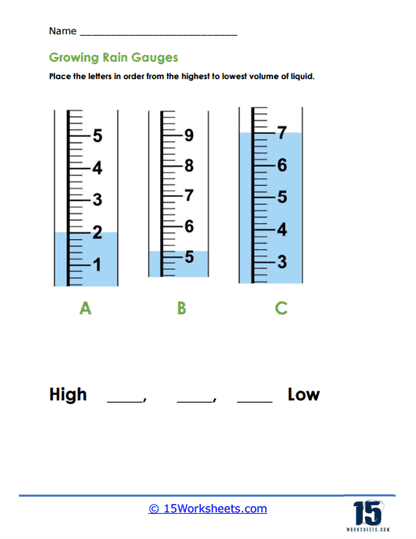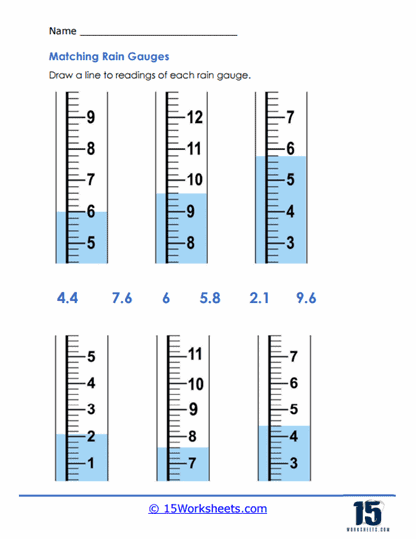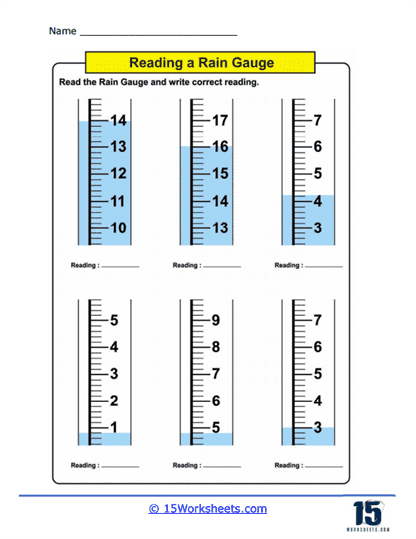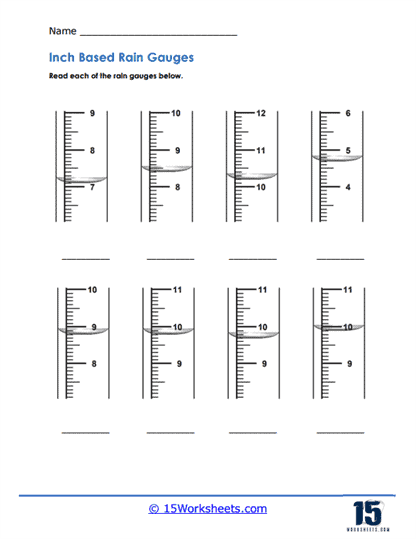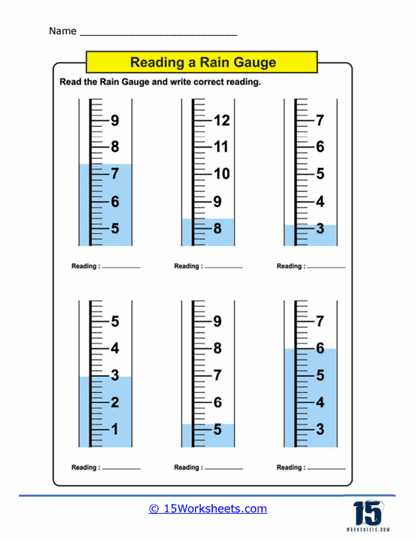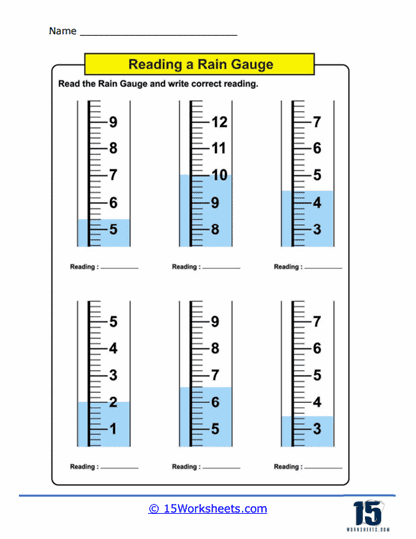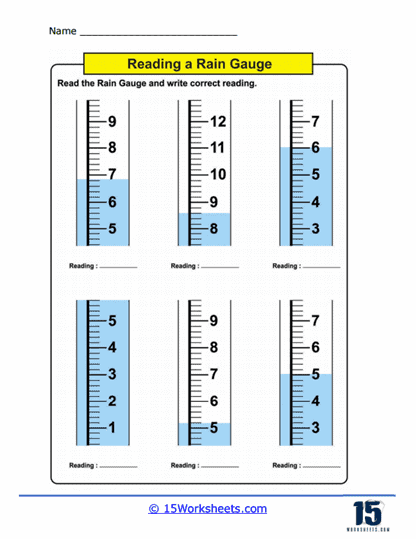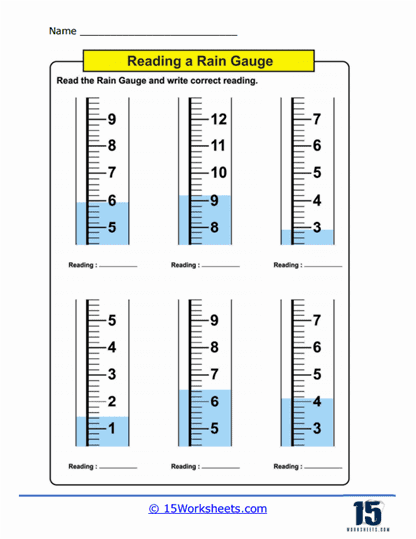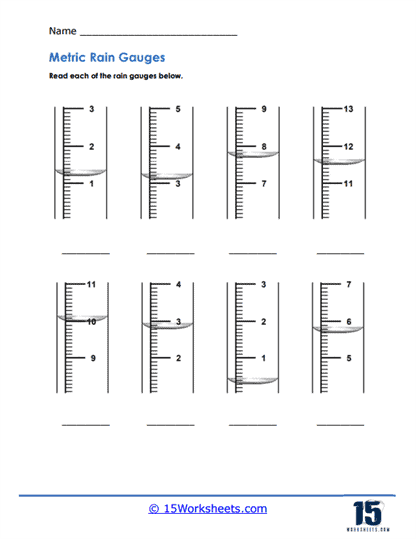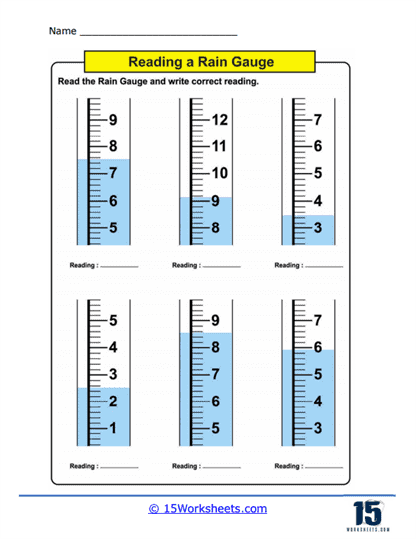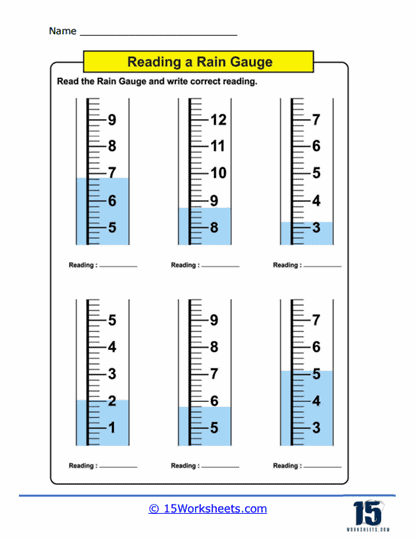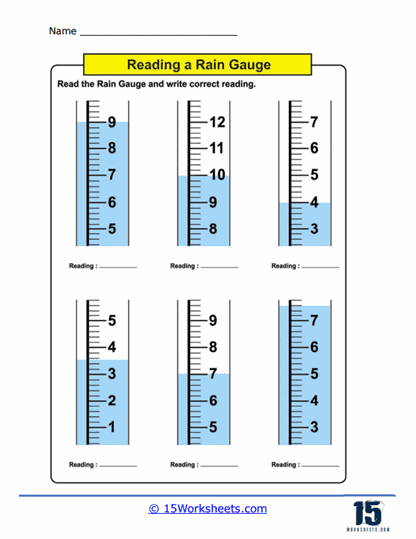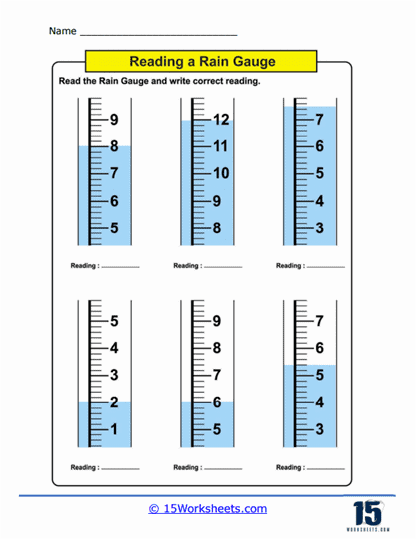Reading Rain Gauges Worksheets
About These 15 Worksheets
These worksheets will help students learn how to interpret measurements from rain gauges accurately. These worksheets are pivotal in subjects like geography, environmental science, and earth sciences, where understanding precipitation is crucial. By using these worksheets, students learn not only how to read the data collected by rain gauges but also appreciate the significance of precipitation data in weather predictions, climate studies, and water resource management.
They not only teach students how to measure and interpret precipitation accurately but also highlight the importance of rainfall data in broader scientific and practical contexts. By working through these worksheets, students enhance their numerical literacy, develop analytical skills, and gain a comprehensive understanding of the environmental factors influenced by rainfall. These skills are invaluable in fostering informed citizens who can contribute thoughtfully to conversations and decisions about environmental management and sustainability.
Understanding Rain Gauges
A rain gauge is an instrument used to measure the amount of liquid precipitation over a set period. Typically, it consists of a cylindrical container that captures rain, which is then measured either manually using a ruler inserted into the container or automatically by the device. The measurements are usually in millimeters or inches, indicating the depth of rainwater that has fallen.
Types of Exercises
Basic Readings – These exercises introduce students to the fundamentals of how a rain gauge works and how to read the measurements it captures. Students might be presented with images of rain gauges showing different water levels and asked to record the measurement. This task helps students practice reading and interpreting the scale on the gauge, which is crucial for accurate data collection.
Recording and Tabulating Rainfall Data – Worksheets may include tables where students need to fill in rainfall data over a series of days or weeks. This practice teaches them how to maintain and interpret long-term data records. Learning to tabulate and maintain accurate records is essential for analyzing trends in weather patterns and assists in developing skills in data management and analysis.
Calculating Average Rainfall – In these exercises, students calculate the average rainfall from a series of measurements. This could involve simple arithmetic to find the mean of a set of numbers. Calculating average rainfall helps students understand variations in weather and is foundational in studies related to climate patterns and agricultural planning.
Comparing Rainfall – Some worksheets might provide data from multiple locations for students to compare and analyze. Students learn how to interpret these comparisons and understand factors influencing varied precipitation levels in different geographical areas. This exercise is crucial for developing a deeper understanding of how local conditions affect weather patterns.
Graphical Representation of Rainfall Data – Exercises that involve plotting rainfall data on graphs are common. Students may be tasked with creating bar graphs, line graphs, or pie charts based on the rainfall data they’ve recorded or been provided. Graphing enhances students’ abilities to visualize data trends and aids in their comprehension of the quantitative aspects of scientific studies. These worksheets ensure that students are comfortable with units of measurement used in recording rainfall, typically millimeters or inches. Exercises often involve converting between these units to reinforce understanding and ensure proficiency with both metric and imperial systems, which is valuable in international scientific contexts.
Analyzing Impacts of Rainfall – Advanced worksheets may link rainfall data to real-world applications, such as agriculture, urban planning, or flood control. Students might analyze how different amounts of rainfall affect crop yields or urban drainage systems. This type of exercise helps students apply their theoretical knowledge to practical, real-world problems. Some worksheets incorporate activities where students use historical rainfall data to predict future weather conditions. This exercise can introduce students to basic concepts in meteorology and the importance of historical data in weather prediction. Problem-solving exercises might involve scenarios where students must decide on the best location to place a rain gauge for accurate measurement, considering factors like obstructions and surface runoff. This develops critical thinking as students consider environmental variables that could affect data accuracy.
What Are Rain Gauges?
Rain gauges are instruments used to measure the amount of liquid precipitation over a specific period of time. Typically, they are used in meteorology, agriculture, hydrology, and climate science to collect and record data on rainfall. This data is crucial for weather forecasting, studying climate patterns, managing water resources, and in agricultural planning.
Types of Rain Gauges
Standard Rain Gauge – This is the most common type and consists of a cylindrical container with a funnel leading into a measuring tube. This design minimizes evaporation and splashing out of the collected water.
Tipping Bucket Rain Gauge – This gauge has a funnel that directs rainfall into a small seesaw-like container. Once a set amount of precipitation collects, typically 0.01 inches, the bucket tips, emptying the water and sending an electronic signal that records the rainfall amount.
Weighing Gauge – Often used in professional meteorological stations, this gauge collects rain in a bucket that is weighed to determine the amount of precipitation. It is highly accurate and can record other forms of precipitation such as snow.
Optical Rain Gauge – Uses a laser beam to detect the amount of rainfall. Interruptions in the beam by raindrops are used to calculate the rain rate.
Uses of Rain Gauges
Rain gauges serve multiple purposes across various fields:
Meteorology – They provide essential data for weather forecasting and monitoring, helping meteorologists understand weather patterns and predict storms.
Agriculture – Farmers rely on accurate rainfall measurements to make informed decisions about irrigation needs and scheduling.
Hydrology – In water resource management, rain gauges help in monitoring water levels of reservoirs and in flood forecasting.
Climate Science – Long-term precipitation data from rain gauges are used to study climate change and its impact on local and global scales.
Using a rain gauge involves several steps to ensure accurate measurements:
Installation – Place the rain gauge in an open area away from buildings, trees, and other structures that could alter the rain entering the gauge. Install the gauge at a height consistent with local meteorological standards (usually at about 1 to 1.5 meters above the ground).
Measurement Process
Standard Gauge – After a rainfall event, remove the cylinder and read the amount of water collected directly from the calibrated measuring tube. The scale will usually be marked in millimeters or inches.
Tipping Bucket – This gauge typically records digitally. Check the connected weather station or digital display to read the amount of rainfall. Each “tip” corresponds to a set amount of rainfall (e.g., 0.01 inches).
Weighing Gauge – Similar to the tipping bucket, the weight of the collected water is often recorded and logged digitally, and can be read from a connected display.
Optical Gauge – Since it uses laser technology, the rainfall data is automatically recorded and can be read on a digital interface.
Regular Maintenance
Clean the gauge regularly to remove any debris, insects, or dirt that might obstruct the rain entry or affect the moving parts in tipping bucket and optical gauges.
In cold weather, antifreeze solution might be added to standard gauges to prevent freezing, but care should be taken as this can affect the accuracy of readings.
Record the measurements at a consistent time daily for standard gauges to maintain consistency in data.
For gauges that record digitally, ensure that the data logs are maintained regularly, and back-ups are created to prevent data loss.
Understanding how to properly use and read a rain gauge is essential for obtaining precise and reliable data. Whether for personal use in a home garden or professional use in meteorology, accurate rainfall measurements can provide valuable insights into weather patterns, aiding in decision-making and planning across various applications.



